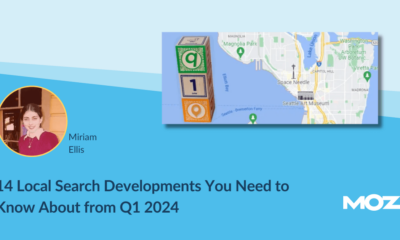MARKETING
Local Economics Through the Lens of Elected Officials and Organizers

The author’s views are entirely his or her own (excluding the unlikely event of hypnosis) and may not always reflect the views of Moz.
If you want to serve local business owners, allying your company with their deepest needs matters. Recently, the Institute for Local Self-Reliance provided a valuable opportunity to hear directly from localism advocates and elected officials about small business owners’ goals and obstacles. If your brand is marketing software or other services to this largest sector of American commerce, I highly recommend setting aside an hour this week to watch the whole recording (embedded at the end of this post).
Today, I’ll briefly recap the information from this event that stood out to me as most illuminating, in hopes that you will be able to evaluate these messages to help you find common cause with clients and customers.
The present state of local economics in the U.S.
ILSR’s co-director, Stacy Mitchell, began the webinar by remarking that, just a decade ago, it was not common to hear much political talk surrounding small businesses versus monopolies, but that this is changing. Advocacy groups are gaining strength and political factions like the 100-member progressive caucus are increasingly getting out the message about the present state of U.S. local economics, which Mitchell summed up this way:
“Today, we know that economic concentration and the losses that we’ve seen both for working people and for small businesses have had devastating effects on communities; that the decline of small businesses and the growing concentration across our communities is really driving racial and economic inequality, ultimately undermining our democracy. And we know that the primary driver of this is corporate power, whether it’s the power these corporations wield in the market or the political power they have to rig government policy in their own favor and to undermine their smaller competitors.”
What local business owners want
Chanda Causer, the Co-Executive Director of The Main Street Alliance, gave this list of priorities she hears voiced by the SMB owners she speaks with every day:
The question was raised as to what business owners and organizers can do to get the public to care about these requirements, and about local economic health. Visiting Fellow at the Harvard Kennedy School’s Shorenstein Center on Media, Politics and Public Policy, Brandi Collins-Dexter explained,
“I think that everybody I talk to cares about this; big business has such a ubiquitous role in our lives that I think people just don’t know what to do about it.”
This quote will resonate with every local search marketer who has been reading survey stats for the past two years that claim three-quarters or more of the public is committed to shopping more locally, and yet, sees how all of our choices have been whittled down to a frustrating dependence on Amazon, Walmart, Target, or dollar store-type options.
I believe that the majority of Americans genuinely do want to shop small and care sincerely about the communities in which they live, but when we need to buy a blender or a book, we increasingly face the stark reality that our town’s independent hardware store or bookshop was driven out of business by economic policy. Meanwhile, our intelligence is repeatedly insulted by monopolies portraying themselves as local heroes and using offensive scare tactics to warn SMBs and the public against any legislation that would limit their profits.
Solutions, obstacles, and hope
If industry surveys and local advocacy groups indicate that the public already cares about the survival of local business owners, we’re already part of the way to solving the dilemma of the economic role of small businesses being cut by 50% over the past 40 years.
What emerged from the ILSR event was a three-part approach to realizing the society that surveys say we want. If implemented, it would take local business owners on a journey from a place of fear to a place of respect and protection.
Education
First, Ms. Causer emphasized the need for continuing dialogue and education, encouraging individuals to take the time to speak about their concerns with their own neighbors, concerns like the effects of monopoly on the community. An educated public is one that can bring pressure to bear on representatives.
Pro-local legislation
Secondly, Congresswoman Pramila Jayapal, who represents the Seattle area and part of King County, is focused on a legislative approach. She is the vice-chair of the subcommittee on antitrust, which conducted a 16-month investigation into the operations of tech monopolies. She introduced HR 3825, designed to prevent corporations like Amazon from demoting merchants on their platforms while simultaneously preferencing their own cheaper product lines – a practice that has been devastating to small entrepreneurs. She is also attempting to directly address the dire needs of all business owners (and the general public) for healthcare amid the pandemic with her HR 1976 Medicare for All bill. As she stated, “The way that local communities do well is to have a thriving small business economy.”
However, Assemblymember Ron Kim, whose district has the largest proportion of small business owners in New York State, was frank about the obstacles standing in the way of the needs of local business owners and communities being met:
“As long as we’re spending, in a place like New York, $7-8 billion a year in tax breaks to subsidize the growth of mega-monopolies and big companies who, in return, donate millions and millions of dollars to executive officers and governors and mayors to keep this game going, we’re going to have a continuous problem.”
Make bribes illegal
This means that the third, and most essential, element in the three-part dynamic is to make it illegal to bribe political candidates and elected officials. Without this stipulation, even the most caring and educated public will find its needs ignored, and pro-local legislation will continue to be defeated by corrupt officials who have been paid by corporations to create policy that serves them.
The scenario may seem hopeless, but it isn’t, because you — who work in tech amid the long-shadowed boulders of monopoly — are reading this article and have a voice. Your co-workers have voices, too, and can advocate for your brands developing authentic allyship with clients and customers.
Our industry has published volumes on the necessity of building relationships with the communities we want to serve. It’s a worthy aspiration, which hinges on listening well and demonstrating solidarity. Honest chats with independent business owners produce stories like Assemblymember Kim’s, about how one of the oldest Korean-American restaurants in his community is becoming a worker co-op to be able to continue operating in a broken economy.
You’ll hear family stories like those of Ms. Collins-Dexter, whose great-grandfather was forced off his land by a powerful tobacco trust, and had to start over again as an auto mechanic whose shop became a major source of community aid during the Great Depression.
You’ll hear neighbors like Ms. Causer explain that 68% of respondents surveyed by her organization want to talk about monopoly, and that she’s advocating for people tp start singing the union songs again — that our grandmothers sang.
And you’ll hear the local business owners whom Congresswoman Jayapal said would only give comments to her antitrust committee in private, because they so fear punishment by the monopolies.
The takeaway
The next time you’re asked how to build out the stages of your customer’s journey, consider asking your team and bosses to begin by donning the shoes of a local business owner. They’re the people in your community who are living in real fear of being put out of business by national, state, and local policy, and of being made invisible by powerful platforms in daring to speak out. Empathy for this plight could be the start of the most genuine relationships your company has ever developed. It could even be the basis of a coalition of industry agencies and SaaS groups bringing their own, collective pressure to bear on public servants, to insist that we finally do get money out of politics and re-balance our economics to prioritize societal well-being.
As a local SEO, I’ve often looked at Google’s local guides program. There are roughly 150 million of these community interpreters globally, and they write an average of 62% of the reviews you read. That’s a lot of people with a lot of potential power, if they ever chose to organize on behalf of the local businesses they so abundantly grade. Why would they do that? Because there is little left to review when a local business landscape is reduced to just one or two monopolies. There is no fun or joy in that.
I think Brandi Collins-Dexter is right about good people not knowing what to do, and I suspect a lot of that feeling of powerlessness is rooted in a sense of isolation. But, just like there are a lot of local guides, there are a lot of tech workers, and together, we can help build the hope we seek from emboldened collaboration.
Watch the recording
MARKETING
18 Events and Conferences for Black Entrepreneurs in 2024

Welcome to Breaking the Blueprint — a blog series that dives into the unique business challenges and opportunities of underrepresented business owners and entrepreneurs. Learn how they’ve grown or scaled their businesses, explored entrepreneurial ventures within their companies, or created side hustles, and how their stories can inspire and inform your own success.
It can feel isolating if you’re the only one in the room who looks like you.
MARKETING
IAB Podcast Upfront highlights rebounding audiences and increased innovation


Podcasts are bouncing back from last year’s slowdown with digital audio publishers, tech partners and brands innovating to build deep relationships with listeners.
At the IAB Podcast Upfront in New York this week, hit shows and successful brand placements were lauded. In addition to the excitement generated by stars like Jon Stewart and Charlamagne tha God, the numbers gauging the industry also showed promise.
U.S. podcast revenue is expected to grow 12% to reach $2 billion — up from 5% growth last year — according to a new IAB/PwC study. Podcasts are projected to reach $2.6 billion by 2026.
The growth is fueled by engaging content and the ability to measure its impact. Adtech is stepping in to measure, prove return on spend and manage brand safety in gripping, sometimes contentious, environments.
“As audio continues to evolve and gain traction, you can expect to hear new innovations around data, measurement, attribution and, crucially, about the ability to assess podcasting’s contribution to KPIs in comparison to other channels in the media mix,” said IAB CEO David Cohen, in his opening remarks.
Comedy and sports leading the way
Podcasting’s slowed growth in 2023 was indicative of lower ad budgets overall as advertisers braced for economic headwinds, according to Matt Shapo, director, Media Center for IAB, in his keynote. The drought is largely over. Data from media analytics firm Guideline found podcast gross media spend up 21.7% in Q1 2024 over Q1 2023. Monthly U.S. podcast listeners now number 135 million, averaging 8.3 podcast episodes per week, according to Edison Research.
Comedy overtook sports and news to become the top podcast category, according to the new IAB report, “U.S. Podcast Advertising Revenue Study: 2023 Revenue & 2024-2026 Growth Projects.” Comedy podcasts gained nearly 300 new advertisers in Q4 2023.
Sports defended second place among popular genres in the report. Announcements from the stage largely followed these preferences.
Jon Stewart, who recently returned to “The Daily Show” to host Mondays, announced a new podcast, “The Weekly Show with Jon Stewart,” via video message at the Upfront. The podcast will start next month and is part of Paramount Audio’s roster, which has a strong sports lineup thanks to its association with CBS Sports.
Reaching underserved groups and tastes
IHeartMedia toasted its partnership with radio and TV host Charlamagne tha God. Charlamagne’s The Black Effect is the largest podcast network in the U.S. for and by black creators. Comedian Jess Hilarious spoke about becoming the newest co-host of the long-running “The Breakfast Club” earlier this year, and doing it while pregnant.
The company also announced a new partnership with Hello Sunshine, a media company founded by Oscar-winner Reese Witherspoon. One resulting podcast, “The Bright Side,” is hosted by journalists Danielle Robay and Simone Boyce. The inspiration for the show was to tell positive stories as a counterweight to negativity in the culture.
With such a large population listening to podcasts, advertisers can now benefit from reaching specific groups catered to by fine-tuned creators and topics. As the top U.S. audio network, iHeartMedia touted its reach of 276 million broadcast listeners.
Connecting advertisers with the right audience
Through its acquisition of technology, including audio adtech company Triton Digital in 2021, as well as data partnerships, iHeartMedia claims a targetable audience of 34 million podcast listeners through its podcast network, and a broader audio audience of 226 million for advertisers, using first- and third-party data.
“A more diverse audience is tuning in, creating more opportunities for more genres to reach consumers — from true crime to business to history to science and culture, there is content for everyone,” Cohen said.
The IAB study found that the top individual advertiser categories in 2023 were Arts, Entertainment and Media (14%), Financial Services (13%), CPG (12%) and Retail (11%). The largest segment of advertisers was Other (27%), which means many podcast advertisers have distinct products and services and are looking to connect with similarly personalized content.
Acast, the top global podcast network, founded in Stockholm a decade ago, boasts 125,000 shows and 400 million monthly listeners. The company acquired podcast database Podchaser in 2022 to gain insights on 4.5 million podcasts (at the time) with over 1.7 billion data points.
Measurement and brand safety
Technology is catching up to the sheer volume of content in the digital audio space. Measurement company Adelaide developed its standard unit of attention, the AU, to predict how effective ad placements will be in an “apples to apples” way across channels. This method is used by The Coca-Cola Company, NBA and AB InBev, among other big advertisers.
In a study with National Public Media, which includes NPR radio and popular podcasts like the “Tiny Desk” concert series, Adelaide found that NPR, on average, scored 10% higher than Adelaide’s Podcast AU Benchmarks, correlating to full-funnel outcomes. NPR listeners weren’t just clicking through to advertisers’ sites, they were considering making a purchase.
Advertisers can also get deep insights on ad effectiveness through Wondery’s premium podcasts — the company was acquired by Amazon in 2020. Ads on its podcasts can now be managed through the Amazon DSP, and measurement of purchases resulting from ads will soon be available.
The podcast landscape is growing rapidly, and advertisers are understandably concerned about involving their brands with potentially controversial content. AI company Seekr develops large language models (LLMs) to analyze online content, including the context around what’s being said on a podcast. It offers a civility rating that determines if a podcast mentioning “shootings,” for instance, is speaking responsibly and civilly about the topic. In doing so, Seekr adds a layer of confidence for advertisers who would otherwise pass over an opportunity to reach an engaged audience on a topic that means a lot to them. Seekr recently partnered with ad agency Oxford Road to bring more confidence to clients.
“When we move beyond the top 100 podcasts, it becomes infinitely more challenging for these long tails of podcasts to be discovered and monetized,” said Pat LaCroix, EVP, strategic partnerships at Seekr. “Media has a trust problem. We’re living in a time of content fragmentation, political polarization and misinformation. This is all leading to a complex and challenging environment for brands to navigate, especially in a channel where brand safety tools have been in the infancy stage.”
Dig deeper: 10 top marketing podcasts for 2024
MARKETING
Foundations of Agency Success: Simplifying Operations for Growth


Why do we read books like Traction, Scaling Up, and the E-Myth and still struggle with implementing systems, defining processes, and training people in our agency?
Those are incredibly comprehensive methodologies. And yet digital agencies still suffer from feast or famine months, inconsistent results and timelines on projects, quality control, revisions, and much more. It’s not because they aren’t excellent at what they do. I
t’s not because there isn’t value in their service. It’s often because they haven’t defined the three most important elements of delivery: the how, the when, and the why.
Complicating our operations early on can lead to a ton of failure in implementing them. Business owners overcomplicate their own processes, hesitate to write things down, and then there’s a ton of operational drag in the company.
Couple that with split attention and paper-thin resources and you have yourself an agency that spends most of its time putting out fires, reacting to problems with clients, and generally building a culture of “the Founder/Creative Director/Leader will fix it” mentality.
Before we chat through how truly simple this can all be, let’s first go back to the beginning.
When we start our companies, we’re told to hustle. And hustle hard. We’re coached that it takes a ton of effort to create momentum, close deals, hire people, and manage projects. And that is all true. There is a ton of work that goes into getting a business up and running.


The challenge is that we all adopt this habit of burning the candle at both ends and the middle all for the sake of growing the business. And we bring that habit into the next stage of growth when our business needs… you guessed it… exactly the opposite.
In Mike Michalowitz’s book, Profit First he opens by insisting the reader understand and accept a fundamental truth: our business is a cash-eating monster. The truth is, our business is also a time-eating monster. And it’s only when we realize that as long as we keep feeding it our time and our resources, it’ll gobble everything up leaving you with nothing in your pocket and a ton of confusion around why you can’t grow.
Truth is, financial problems are easy compared to operational problems. Money is everywhere. You can go get a loan or go create more revenue by providing value easily. What’s harder is taking that money and creating systems that produce profitably. Next level is taking that money, creating profit and time freedom.
In my bestselling book, The Sabbatical Method, I teach owners how to fundamentally peel back the time they spend in their company, doing everything, and how it can save owners a lot of money, time, and headaches by professionalizing their operations.
The tough part about being a digital agency owner is that you likely started your business because you were great at something. Building websites, creating Search Engine Optimization strategies, or running paid media campaigns. And then you ended up running a company. Those are two very different things.


How to Get Out of Your Own Way and Create Some Simple Structure for Your Agency…
- Start Working Less
I know this sounds really brash and counterintuitive, but I’ve seen it work wonders for clients and colleagues alike. I often say you can’t see the label from inside the bottle and I’ve found no truer statement when it comes to things like planning, vision, direction, and operations creation.
Owners who stay in the weeds of their business while trying to build the structure are like hunters in the jungle hacking through the brush with a machete, getting nowhere with really sore arms. Instead, define your work day, create those boundaries of involvement, stop working weekends, nights and jumping over people’s heads to solve problems.
It’ll help you get another vantage point on your company and your team can build some autonomy in the meantime.
- Master the Art of Knowledge Transfer
There are two ways to impart knowledge on others: apprenticeship and writing something down. Apprenticeship began as a lifelong relationship and often knowledge was only retained by ONE person who would carry on your method.
Writing things down used to be limited (before the printing press) to whoever held the pages.
We’re fortunate that today, we have many ways of imparting knowledge to our team. And creating this habit early on can save a business from being dependent on any one person who has a bunch of “how” and “when” up in their noggin.
While you’re taking some time to get out of the day-to-day, start writing things down and recording your screen (use a tool like loom.com) while you’re answering questions.


Deposit those teachings into a company knowledge base, a central location for company resources. Some of the most scaleable and sellable companies I’ve ever worked with had this habit down pat.
- Define Your Processes
Lean in. No fancy tool or software is going to save your company. Every team I’ve ever worked with who came to me with a half-built project management tool suffered immensely from not first defining their process. This isn’t easy to do, but it can be simple.
The thing that hangs up most teams to dry is simply making decisions. If you can decide how you do something, when you do it and why it’s happening that way, you’ve already won. I know exactly what you’re thinking: our process changes all the time, per client, per engagement, etc. That’s fine.
Small businesses should be finding better, more efficient ways to do things all the time. Developing your processes and creating a maintenance effort to keep them accurate and updated is going to be a liferaft in choppy seas. You’ll be able to cling to it when the agency gets busy.
“I’m so busy, how can I possibly work less and make time for this?”


You can’t afford not to do this work. Burning the candle at both ends and the middle will catch up eventually and in some form or another. Whether it’s burnout, clients churning out of the company, a team member leaving, some huge, unexpected tax bill.
I’ve heard all the stories and they all suck. It’s easier than ever to start a business and it’s harder than ever to keep one. This work might not be sexy, but it gives us the freedom we craved when we began our companies.
Start small and simple and watch your company become more predictable and your team more efficient.
-

 PPC6 days ago
PPC6 days agoHow the TikTok Algorithm Works in 2024 (+9 Ways to Go Viral)
-

 SEO7 days ago
SEO7 days agoBlog Post Checklist: Check All Prior to Hitting “Publish”
-

 SEO5 days ago
SEO5 days agoHow to Use Keywords for SEO: The Complete Beginner’s Guide
-

 MARKETING6 days ago
MARKETING6 days agoHow To Protect Your People and Brand
-

 SEARCHENGINES7 days ago
SEARCHENGINES7 days agoGoogle Started Enforcing The Site Reputation Abuse Policy
-

 PPC7 days ago
PPC7 days agoHow to Craft Compelling Google Ads for eCommerce
-

 MARKETING6 days ago
MARKETING6 days agoElevating Women in SEO for a More Inclusive Industry
-

 PPC6 days ago
PPC6 days agoHow to Brainstorm Business Ideas: 9 Fool-Proof Approaches

















You must be logged in to post a comment Login